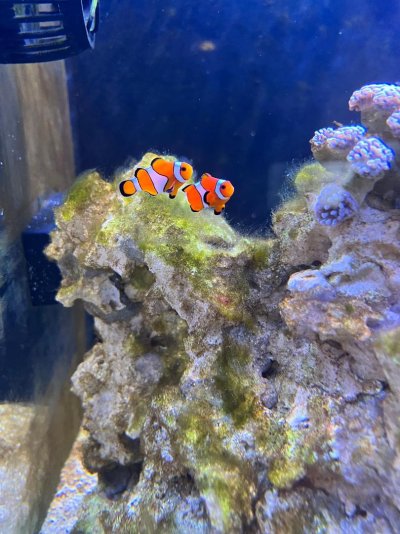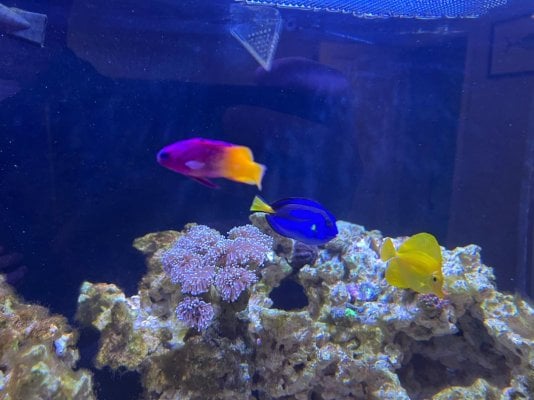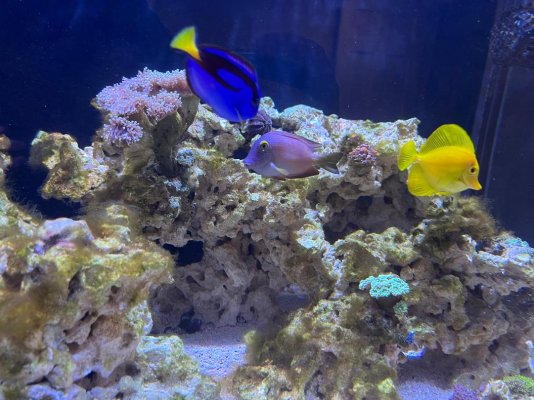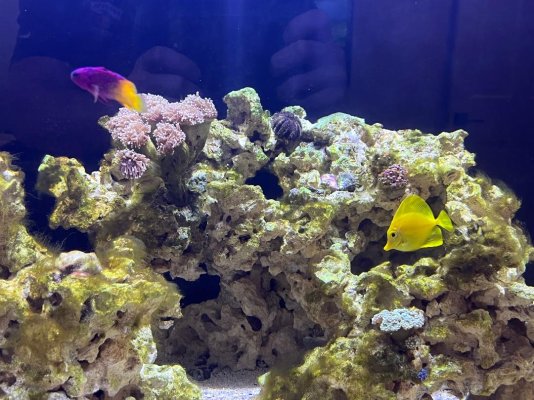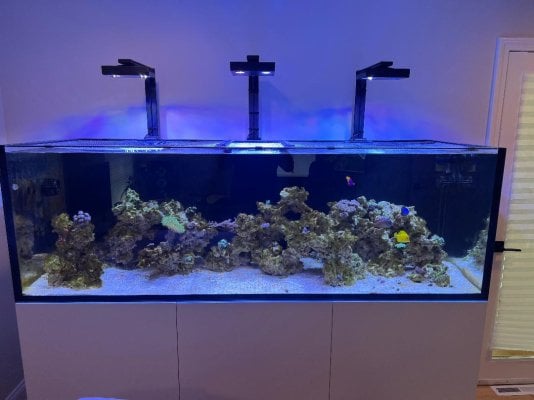Hello there,
In late April of 2024 I purchased 4 Dispar Anthias. They arrived in great condition, and took to acclimation very well. Knowing the challenges of keeping Anthias I readily fed them throughout the days and 4 out of the 5 put on good weight and looked very healthy. One of the 5 did not put on weight, got very skinny and eventually died, maybe about a month after arrival. The remaining 4 were incredibly healthy, and would readily eat out of my hand. They showed great colors and behaviors all the time.
Fast forward to yesterday morning - I did my normal routine which is putting in 2 cubes of frozen food (the type varied throughout the day, but these two cubes were PE Mysis shrimp) into a slow feeder/defroster for them to eat throughout the morning. I am near the end of this frozen blister pack, so they have been eating this exact food for about a month, in conjunction with other foods. All 4 Anthias were grouped up by the opening in the tank where I put their food in, as they have done every time I walk in the room. I spent the day on the road for work and went to do a water change when I got home last night, and found that all 4 anthias were dead. No other fish or corals in my tank are showing any sign of stress or illness.
My tank is a Waterbox Infinia Reef 230.6 which was setup in March. However, I had cured media from another system of mine that was ~3 years old. The stocking of the tank now consists of a 4.5" Kole tang, 2.5" Regal Tang, a 3" Yellow Tang, two juvenile Clown Fish and a Royal Gramma, along with a mixture of snails and hermits. None of these fish have shown any aggression, and I have a somewhat significant 'negative space' style aquascape for plenty of hiding. One of the anthia's bodies had been mostly stripped by the CUC that was piled on it, but the other bodies looked completely normal (almost still alive) with no sign of injury or disease.
I have recently been having a brown film issue (I think Diatoms, but not confirmed) which I believe was due to my low nutrients - 0 reading on my Hanna Phosphate Checker (not ULR) and around 2-3 on my Hanna Nitrate Checker with no green algae growth anywhere in the tank. In an attempt to fix this issue brown film issue, about 6 weeks ago I reduced my water change schedule to ~30% per month (down from 30% every 2 weeks) and turned off my skimmer. This has slowly brought up my phosphate which was at .06 when checked last night, and has significantly reduced the brown film, allowed small amounts of GHA growth and I am now seeing spots of calcareous algae growth. I regularly check my salinity, which sits right at 35 PPT. Aside from this reduction in water change schedule and turning off of my skimmer ~6 weeks ago, there have been no other changes and no new fish or corals added. All equipment is working as expected (redundant heater controllers, lights, return pump and circulation pumps are all monitored and alarmed remotely), and there was nobody in my home that could have tampered with or done anything to the tank.
The only variable I can think of is the PE Mysis shrimp, but even that feels like a stretch since they have been happily eating it for at least a month, and none of the other fish in the tank are showing any symptoms whatsoever. I am at a loss in trying to diagnose what happened, and I am open to any insights that the community may have. If I left out any pertinent information that would help diagnose please let me know and I will include it.
Much appreciated,
Soup
In late April of 2024 I purchased 4 Dispar Anthias. They arrived in great condition, and took to acclimation very well. Knowing the challenges of keeping Anthias I readily fed them throughout the days and 4 out of the 5 put on good weight and looked very healthy. One of the 5 did not put on weight, got very skinny and eventually died, maybe about a month after arrival. The remaining 4 were incredibly healthy, and would readily eat out of my hand. They showed great colors and behaviors all the time.
Fast forward to yesterday morning - I did my normal routine which is putting in 2 cubes of frozen food (the type varied throughout the day, but these two cubes were PE Mysis shrimp) into a slow feeder/defroster for them to eat throughout the morning. I am near the end of this frozen blister pack, so they have been eating this exact food for about a month, in conjunction with other foods. All 4 Anthias were grouped up by the opening in the tank where I put their food in, as they have done every time I walk in the room. I spent the day on the road for work and went to do a water change when I got home last night, and found that all 4 anthias were dead. No other fish or corals in my tank are showing any sign of stress or illness.
My tank is a Waterbox Infinia Reef 230.6 which was setup in March. However, I had cured media from another system of mine that was ~3 years old. The stocking of the tank now consists of a 4.5" Kole tang, 2.5" Regal Tang, a 3" Yellow Tang, two juvenile Clown Fish and a Royal Gramma, along with a mixture of snails and hermits. None of these fish have shown any aggression, and I have a somewhat significant 'negative space' style aquascape for plenty of hiding. One of the anthia's bodies had been mostly stripped by the CUC that was piled on it, but the other bodies looked completely normal (almost still alive) with no sign of injury or disease.
I have recently been having a brown film issue (I think Diatoms, but not confirmed) which I believe was due to my low nutrients - 0 reading on my Hanna Phosphate Checker (not ULR) and around 2-3 on my Hanna Nitrate Checker with no green algae growth anywhere in the tank. In an attempt to fix this issue brown film issue, about 6 weeks ago I reduced my water change schedule to ~30% per month (down from 30% every 2 weeks) and turned off my skimmer. This has slowly brought up my phosphate which was at .06 when checked last night, and has significantly reduced the brown film, allowed small amounts of GHA growth and I am now seeing spots of calcareous algae growth. I regularly check my salinity, which sits right at 35 PPT. Aside from this reduction in water change schedule and turning off of my skimmer ~6 weeks ago, there have been no other changes and no new fish or corals added. All equipment is working as expected (redundant heater controllers, lights, return pump and circulation pumps are all monitored and alarmed remotely), and there was nobody in my home that could have tampered with or done anything to the tank.
The only variable I can think of is the PE Mysis shrimp, but even that feels like a stretch since they have been happily eating it for at least a month, and none of the other fish in the tank are showing any symptoms whatsoever. I am at a loss in trying to diagnose what happened, and I am open to any insights that the community may have. If I left out any pertinent information that would help diagnose please let me know and I will include it.
Much appreciated,
Soup









